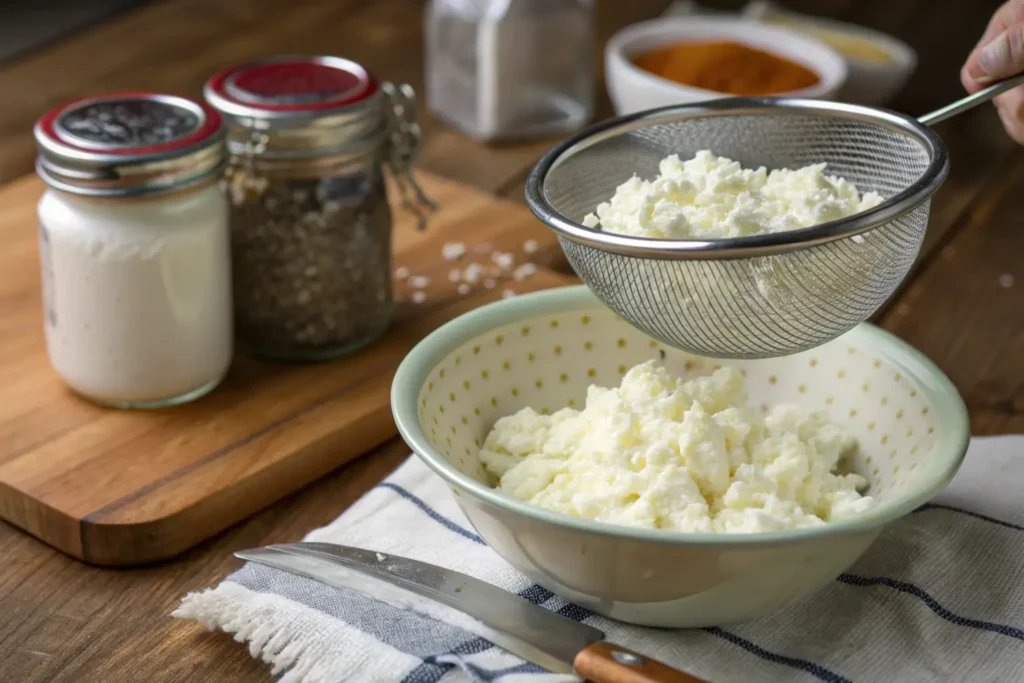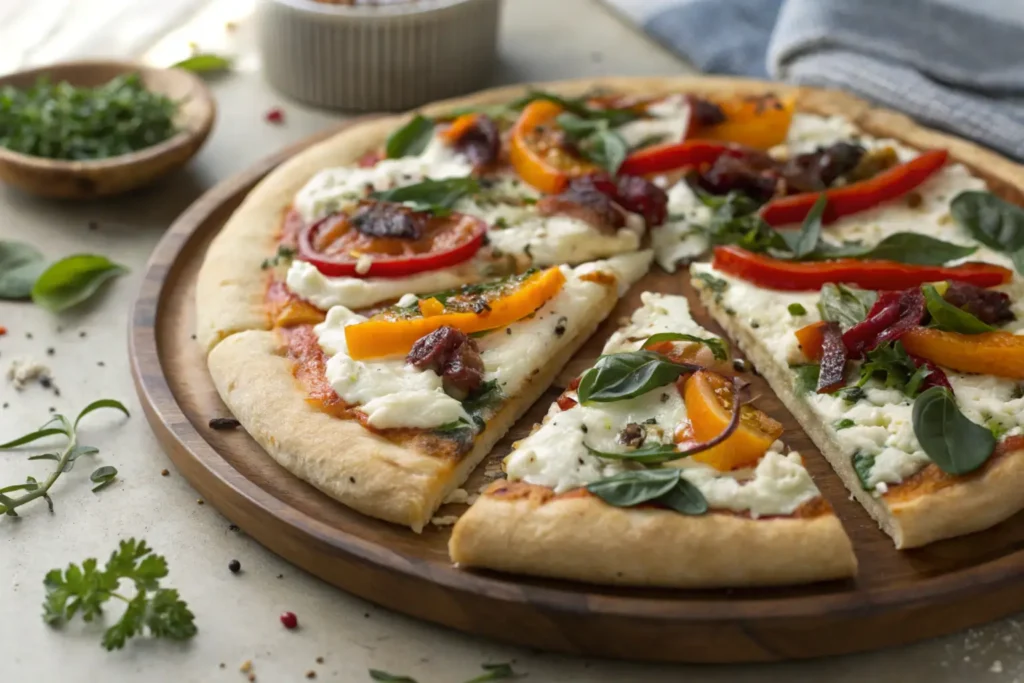Introduction to Cottage Cheese as a Pizza Topping
When you think about pizza, the first thing that probably comes to mind is a gooey layer of mozzarella cheese stretching with every bite. But have you ever wondered if cottage cheese could have a spot on your pizza? This creamy, slightly tangy cheese is having a moment, and people are getting creative with how they use it. From health-conscious eaters to foodies chasing bold flavors, cottage cheese is slowly finding its way into pizza recipes—and it’s worth talking about.
What Makes Cottage Cheese Unique?
Cottage cheese stands out because of its texture. Unlike smooth, stretchy cheeses, it has a chunky, curd-like consistency. That might sound odd for pizza, but hear me out. Its mild, slightly salty flavor blends beautifully with bold sauces and toppings. Plus, it’s packed with protein and lighter on calories, making it a healthier alternative for your cheesy cravings. Think of it as a fresh twist that adds personality to every slice.
The Growing Trend of Unconventional Pizza Ingredients
These days, pizza isn’t just about pepperoni and mozzarella. People are branching out with everything from smoked salmon to figs as toppings. Cottage cheese fits perfectly into this trend of pushing the boundaries of what pizza can be. It’s a fun way to shake up your dinner routine and surprise your taste buds. Honestly, it’s a trend that feels both fancy and approachable at the same time.
The History of Cottage Cheese in Culinary Traditions
Origins of Cottage Cheese
Cottage cheese has been around for centuries. Its roots trace back to simple, farm-made cheese recipes where leftover milk was allowed to curdle naturally. The name itself comes from the idea of small-batch cheese made in cottages—hence the cozy, homemade vibe it carries even today. Over time, it has evolved into a staple in diets worldwide, celebrated for its versatility and nutritional benefits.
Traditional Uses in Global Cuisines
You might know cottage cheese as a breakfast side or something you throw into a salad, but in global cuisines, it has a much broader role. In India, for example, paneer—a firmer version of cottage cheese—is used in curries and fried dishes. In Eastern Europe, it shows up in dumplings and pastries. While pizza isn’t a traditional home for cottage cheese, its adaptability makes it a great candidate for new and exciting recipes.
Nutritional Benefits of Cottage Cheese on Pizza
High Protein Content and Its Advantages
If you’re into eating healthy without sacrificing flavor, cottage cheese is a game-changer. One cup of this cheese packs a serious punch of protein, which helps keep you full longer. Adding it to your pizza means you’re not just indulging—you’re getting a satisfying, protein-packed meal. It’s especially great for gym-goers or anyone trying to hit their daily protein goals without piling on too many calories.
Low-Calorie Option for Health-Conscious Eaters
Let’s be real—pizza can be a calorie bomb. But swapping out traditional cheeses for cottage cheese gives you a lighter option that doesn’t skimp on flavor. With fewer calories and less fat than mozzarella or cheddar, cottage cheese can help you enjoy pizza night without the guilt. It’s the kind of small change that makes a big difference when you’re trying to eat healthier.
Comparing Cottage Cheese to Traditional Pizza Cheeses
Mozzarella vs. Cottage Cheese: Texture and Meltability
Let’s get one thing straight—cottage cheese and mozzarella are two very different kinds of cheese. Mozzarella is smooth, stretchy, and melts beautifully. Cottage cheese, on the other hand, has a chunky, curd-like texture that doesn’t really melt in the traditional sense. But that doesn’t mean it can’t work on a pizza. When used creatively, cottage cheese can add a creamy layer that pairs beautifully with crispy crusts and flavorful toppings. It’s just about understanding its quirks and leaning into them.
Flavor Profile Differences and Pairings
Cottage cheese is mild and slightly tangy, making it a versatile base for pairing with other ingredients. While mozzarella’s flavor is more neutral, cottage cheese has a little extra kick that complements bold sauces like marinara or pesto. Add a sprinkle of fresh herbs like basil or oregano, and you’ve got a flavor combo that’s as unexpected as it is delicious. Think of it as the cheese that’s ready to bring some personality to your pizza night.
How to Prepare Cottage Cheese for Pizza

Draining Excess Moisture for Optimal Results
If you’ve ever worked with cottage cheese, you know it can be pretty watery. That’s not exactly what you want on a pizza, where too much moisture can make the crust soggy. To fix this, grab a fine-mesh strainer or some cheesecloth and let the cheese drain for a bit before using it. This small step goes a long way in making sure your pizza stays crisp and delicious. Nobody wants a floppy crust, right?
Blending Cottage Cheese for a Smoother Texture
For those who aren’t a fan of the curd-like texture, blending cottage cheese can make it smoother and more spreadable. A quick blitz in the food processor transforms it into a creamy consistency that’s perfect for spreading over your pizza base. This works especially well if you’re aiming for a more traditional look while still enjoying all the health benefits of cottage cheese.
Popular Pizza Styles Featuring Cottage Cheese
Vegetarian and Vegan Pizza Variations
Cottage cheese is a natural fit for vegetarian pizzas. Its creamy texture pairs beautifully with roasted veggies like zucchini, bell peppers, and mushrooms. For those leaning vegan, you can even find plant-based versions of cottage cheese that work surprisingly well. Add some fresh spinach and sun-dried tomatoes, and you’ve got a veggie-packed pizza that’s as tasty as it is wholesome.
Gluten-Free and Low-Carb Options
If you’re on a gluten-free or low-carb diet, cottage cheese can be a fantastic addition to alternative pizza bases like cauliflower crusts or almond flour crusts. Its lighter consistency complements these bases without overwhelming them. Add toppings like grilled chicken or fresh arugula for a satisfying meal that checks all the boxes. It’s proof that you don’t have to sacrifice flavor just because you’re cutting back on carbs or gluten.
Step-by-Step Guide to Making Cottage Cheese Pizza
Choosing the Right Base and Sauce
The foundation of any good pizza is its crust and sauce. For a cottage cheese pizza, you’ll want to pick a base that balances the cheese’s creamy texture. Thin crusts work well if you’re going for a lighter vibe, while thicker crusts can handle more toppings. As for sauces, marinara is a classic choice, but don’t be afraid to try pesto or even a white garlic sauce for something different. The goal is to let the cottage cheese shine without overpowering it.
Layering Techniques for Even Distribution
Layering is key when it comes to getting the most out of your cottage cheese pizza. Start with a thin layer of sauce, followed by a spread of cottage cheese. From there, add your toppings, making sure to distribute them evenly. A little goes a long way, especially with bold ingredients like olives or jalapeños. The trick is to create a balance where every bite feels intentional and delicious.
Creative Topping Combinations with Cottage Cheese

Pairing with Vegetables and Herbs
When it comes to veggies, cottage cheese is like a blank canvas that lets other flavors shine. Roasted cherry tomatoes, caramelized onions, and fresh spinach are fantastic choices. Sprinkle on some fresh herbs like basil, parsley, or thyme for an aromatic touch. You could even go seasonal with ingredients like butternut squash or asparagus. These combinations not only taste great but also add a pop of color that makes your pizza look as good as it tastes.
Incorporating Meats and Savory Additions
If you’re a meat lover, cottage cheese pairs wonderfully with options like grilled chicken, crispy bacon, or even thin slices of prosciutto. The creamy texture balances out the saltiness of the meat, creating a harmony of flavors. For a little extra kick, try adding a sprinkle of chili flakes or a drizzle of honey. It’s these small touches that take your pizza from good to unforgettable.
Baking Tips for the Perfect Cottage Cheese Pizza
Ideal Oven Temperature and Cooking Time
The secret to a perfect pizza lies in your oven setup. Preheat your oven to around 450°F for the best results. If you’re using a pizza stone, let it heat up with the oven to get that perfect crispy crust. Bake your pizza for 10 to 12 minutes or until the edges are golden and the toppings are cooked to perfection. Keep an eye on it, though—every oven is a little different.
Achieving the Desired Crispiness and Flavor
If you’re craving a crispy crust, don’t overload your pizza with toppings. Too many ingredients can weigh it down and make it soggy. Also, brushing the edges of your crust with olive oil before baking can give it a beautiful golden finish. For an extra flavor boost, sprinkle a little garlic powder or grated Parmesan on the crust before popping it in the oven.
Serving and Presentation Ideas
Garnishing for Visual Appeal
They say you eat with your eyes first, so don’t skip the garnishes. A handful of arugula or microgreens tossed on top just before serving adds a fresh, vibrant touch. You can also drizzle a little balsamic glaze or a flavored olive oil for that wow factor. It’s all about those little details that make your pizza feel restaurant-quality, even if it’s homemade.
Pairing with Dips and Side Dishes
To round out your pizza night, think about pairing it with dips like marinara, ranch, or garlic butter. Side dishes like a crisp Caesar salad or roasted veggies can complement your pizza without overshadowing it. And let’s be honest, a little bowl of chips or breadsticks on the side never hurts.
Storing and Reheating Leftover Cottage Cheese Pizza
Best Practices for Refrigeration
If you have leftovers (lucky you), let the pizza cool completely before storing it. Place slices in an airtight container with parchment paper between layers to prevent sticking. Refrigerated pizza is best enjoyed within three days to keep the flavors and textures intact.
Maintaining Texture and Flavor When Reheating
Reheating pizza can be tricky, but a little patience goes a long way. Skip the microwave and go for the oven or a hot skillet. In the oven, reheat slices at 375°F for about 8 to 10 minutes. For the skillet method, place the pizza on low heat, cover it, and let it warm through for a crispy bottom and melty toppings. Trust me, it’s worth the extra effort.
Common Mistakes to Avoid When Using Cottage Cheese
Overloading the Pizza with Toppings
It’s tempting to go all out with toppings, but too much of a good thing can backfire. Overloading your pizza with too many ingredients can make it soggy and hard to handle. Stick to a few well-chosen toppings that complement each other and let the cottage cheese take center stage.
Ignoring Moisture Control Techniques
Moisture is the enemy of a good pizza crust. If you skip draining your cottage cheese or forget to pat your veggies dry, you’re setting yourself up for disappointment. Take the time to prep your ingredients properly—it’s a simple step that makes a huge difference in the final result.
Exploring Regional Variations of Cottage Cheese Pizza
Mediterranean-Inspired Recipes
For a Mediterranean twist, use ingredients like kalamata olives, artichoke hearts, and sun-dried tomatoes. Combine these with a drizzle of olive oil and a sprinkle of feta cheese for a flavor-packed pizza that transports you straight to the coast of Greece.
Fusion Styles Combining Global Flavors
Why stop at Mediterranean when you can mix it up even more? Try a fusion pizza with flavors from around the world. Think cottage cheese with tikka masala sauce, or go for a Thai-inspired pizza with peanut sauce, shredded carrots, and fresh cilantro. The possibilities are endless, and the results are always exciting.
Feedback from Home Cooks and Professional Chefs
Testimonials and Success Stories
Home cooks rave about how cottage cheese has completely changed their pizza game. Many say it’s a great way to make pizza feel lighter without losing any of the indulgent flavors they love. Chefs, on the other hand, appreciate its versatility and ability to blend with bold ingredients.
Expert Tips for Enhancing the Dish
Chefs recommend experimenting with spices and herbs to elevate your cottage cheese pizza. A pinch of smoked paprika or a dusting of fresh black pepper can add depth to the flavors. And don’t forget the power of fresh toppings added after baking, like arugula or shaved Parmesan.
FAQs
Does cottage cheese melt?
Not exactly. Cottage cheese doesn’t melt like mozzarella, but it softens and blends well when heated. This gives your pizza a creamy texture without the stretchy effect of traditional cheeses.
Can cottage cheese be substituted for ricotta on pizza?
Yes, cottage cheese is a great substitute for ricotta. It’s lighter in texture and calories but still provides that creamy, rich flavor. For a smoother consistency, you can blend it before using.
What cheese is good on pizza besides mozzarella?
Besides mozzarella, cheeses like provolone, gouda, and Parmesan are excellent choices. For something unique, give cottage cheese, ricotta, or even goat cheese a try. Each brings its own flavor and texture to the table.
What is the healthiest thing to put on a pizza?
The healthiest toppings include plenty of veggies like spinach, bell peppers, and tomatoes. Lean proteins like grilled chicken or turkey sausage are also great options. Using a lighter cheese like cottage cheese or skipping cheese altogether can help keep things even healthier.
Conclusion: Embracing Cottage Cheese on Pizza
Why Cottage Cheese is a Versatile Topping
Cottage cheese proves that you don’t need to stick to the usual pizza rules. Its creamy texture, mild flavor, and nutritional benefits make it a versatile option for anyone looking to mix things up. Whether you’re experimenting with new recipes or trying to eat a little healthier, it’s worth a spot on your pizza.
Encouraging Experimentation in the Kitchen
At the end of the day, pizza is all about creativity. Don’t be afraid to step outside your comfort zone and try something new. With cottage cheese as your secret weapon, the possibilities are endless—and delicious.


4 thoughts on “Can cottage cheese be used on pizza? Everything You Need to Know”